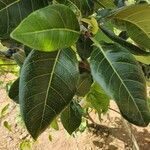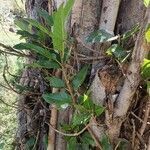Free-standing, deciduous tree, up to 18 m high and 30 m wide, or small rock-splitter. Leaves stiff, ovate, oblong-lanceolate or lanceolate (45-165 x 27-85 mm), dark olive-green, somewhat glossy; veins distinctly pale, base usually square, sometimes rounded or cordate, apex acuminate; petioles 6-42 mm long. Syconia (figs) stalked, often shortly, borne in pairs or singly in leaf axils, or on bare twigs below leaves, round to pear-shaped, 10-13 mm in diam., smooth, with or without small warts, finely hairy or hairless, creamish green, turning pinkish when ripe.
A fig. It is a small tree which loses its leaves. It is an erect tree and has a spreading crown. It grows up to 15 m tall. The branches touch the ground. It grows attached to other plants. The leaves are oval. They are 6-15 cm long by 3-10 cm wide. They are pale green and thinly textured. The new leaves are red. The base is slightly lobed and it tapers towards the tip. The fig fruit grow in the axils of the leaves. The fruit are round and 1-1.5 cm across. They are pale yellow or pink when ripe.
Leaf lamina ovate to elliptic, oblong or sometimes lanceolate, (2.5)5–20 x (2)3–11 cm., coriaceous; apex shortly acuminate to acute, sometimes to obtuse; base cordate, occasionally truncate or ± broadly cuneate; margin entire; both surfaces glabrous; lateral veins 8–11 pairs, the (main) basal pairs ± distinctly branched, almost straight and thus not running parallel to the margin, the other veins often furcate far from the margin.
Figs in pairs in the leaf axils or just below the leaves, subsessile or on peduncles up to 0.5 mm. long; basal bracts c. 2 mm. long; receptacle subglobose, 1–2 cm. in diam. when fresh, 0.5–1 cm. in diam. when dry, minutely white to brown puberulous or partly hirtellous, sometimes densely tomentose or pubescent, whitish pink to pale or dark purple at maturity; wall wrinkled when dry.
Petiole 0.5–4 cm. long, 1–3 mm. thick; stipules 0.5–1 cm. long, densely yellowish-tomentose to subvelutinous or glabrous, caducous.
Monoecious tree to 15 m, bark grey. Leaves ovate, lateral veins ± 8. Figs axillary, pedunculate, 9-12 mm diam., pink.
Leafy twigs 3–6 mm. thick, sparsely pubescent to densely tomentellous or subvelutinous, indumentum white to brownish.
Tree up to 15 m. tall.





